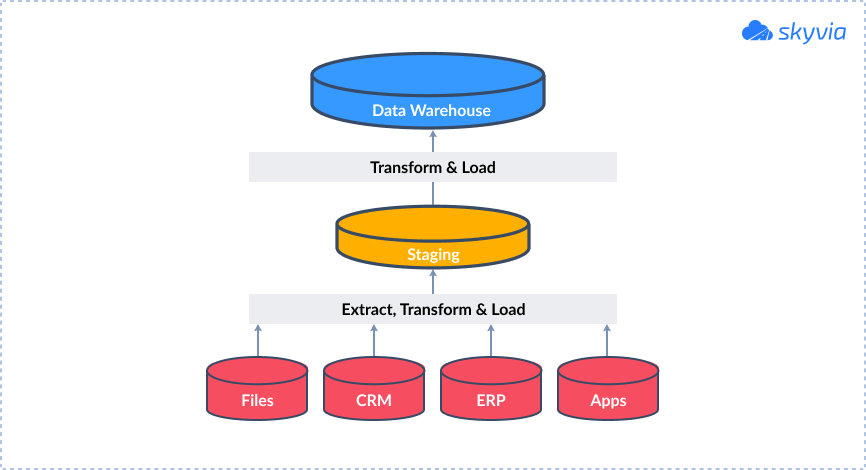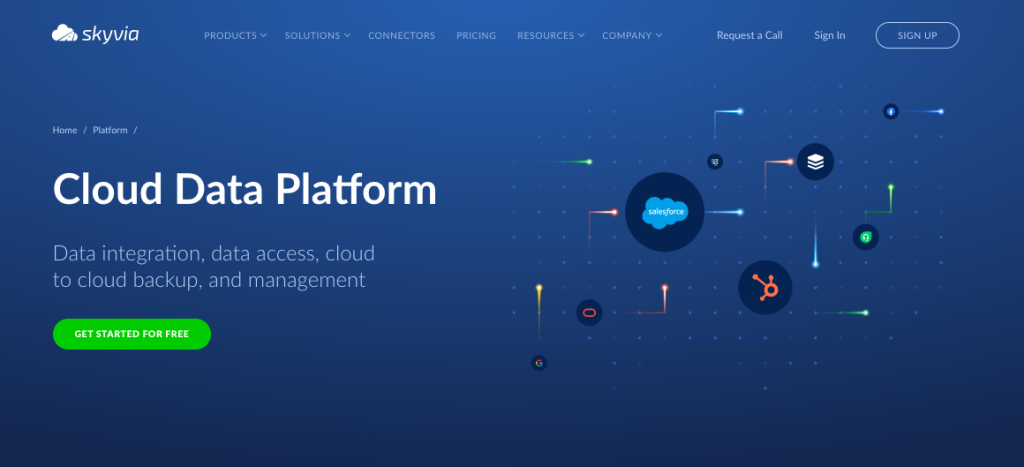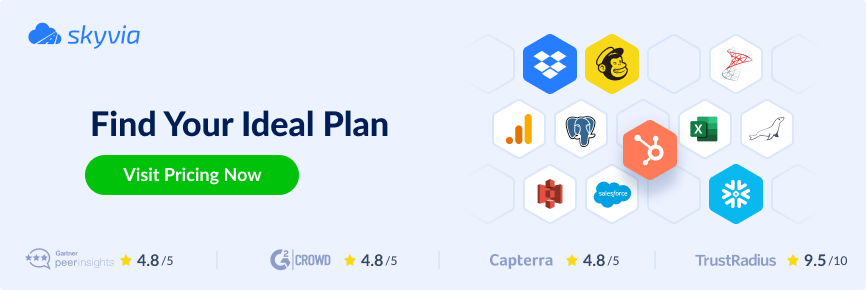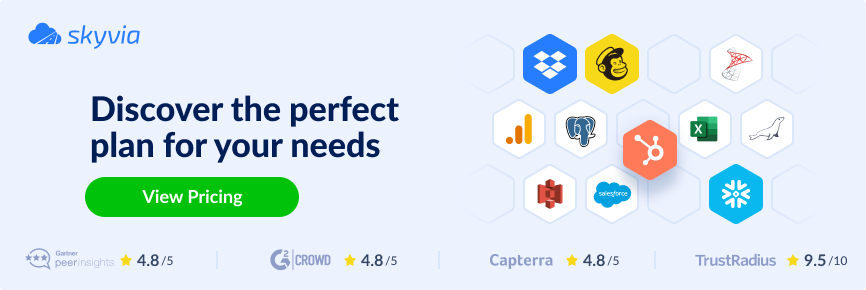To better understand the essence of something, it’s worth discovering its roots. So, let’s dive into the origins of the term ‘consolidation’ first and then take a closer look at what the term ‘data consolidation’ conceals and how to apply it in a business environment.
The Latin word ‘consolidātus’ signifies the process of bringing together different things to make them easier to handle. In the context of data consolidation, it means combining data from various services in a central point for better control and management. The statistics show that 35% of businesses have already switched to automated solutions, which have helped them reduce human error and boost organizational processes.
We’re here to discuss how to streamline the consolidation of data with the use of dedicated tools such as Skyvia. We also talk about when it’s the right time to do that, what benefits it brings to companies and particular techniques for data consolidation.
Table of Contents
- The Need for Data Consolidation
- What is Data Consolidation?
- How Does Data Consolidation Work?
- What Are The Reasons For Data Consolidation In Businesses?
- What Kinds of Data Are Unstructured And Difficult To Analyze?
- Cutting-Edge Tool for Data Consolidation
- What Are the Key Guidelines for Effective Data Consolidation?
- Conclusion
The Need for Data Consolidation
When apples are sun-drenched and ready for harvesting, farmers prepare boxes and other necessary equipment to pick them up from the trees. When snowflakes whirl around the city and create a solid white planking on the ground, communal services take their snow blowers to make streets passable for people and cars.
Similarly to natural seasonal changes, the stages of the anthropogenic world evolve. We’re now in another technological revolution with the outburst of the digital world. Its expansion is like a chemical chain reaction, where the amount of digital data only grows exponentially.
This data comes from HR tools, project management software, CRM systems, and many others. According to Statista, an organization uses 130 SaaS services on average, while this number was 8 apps in 2015.
Obviously, the selection of tools depends on various factors: employees, processes, locations, technologies, etc. And as each app has a definite purpose, it operates in a so-called data silo. This, in turn, causes multiple risks for businesses: security, data discrepancy, elevated costs, and slowed down decision-making. Around 85% of companies stated that they view a direct correlation between silos and security risks.
One of the methods to address such risks is to consolidate data from various sources.
What is Data Consolidation?
We’ve already discussed this term in the introduction, but now, let’s focus on it precisely.
As this notion is relatively new, even seasoned IT experts might find it hard to answer the question, “What is consolidation of data?”. What’s more, it’s even difficult to find an official definition of this term in any dictionary. Luckily, there are some online sources that work on the definition of neologisms in modern English. For instance, Technopedia states that ‘data consolidation’ is the collection and integration of data from multiple sources to a central destination.
Very often, data consolidation is also mistakenly perceived as data integration, while it’s not really so. Integration of data only makes a part of the process, and it’s more about technological implementation, while consolidation is a concept of working with data.
How Does Data Consolidation Work?
In the good old times, when computers with Windows XP gained immense popularity, people already knew about data consolidation. However, all that stuff was done either manually or by writing complex scripts with the help of programming languages. Experts who did that were seen as genius creatures who made miracles.
Nowadays, consolidating data doesn’t require any superpower but still demands solid expertise in databases and an understanding of fundamental IT concepts. This allows the use of modern tools for various types of data consolidation.
ETL
One of the probably most well-known examples of data consolidation is the use of ETL tools. They are destined to extract data, apply transformations to it, and load it to another application or database.

- The first stage, called Extract, assumes that data is ingested from existing databases or data warehouses, legacy systems, CRMs, mobile apps, and so on.
- The second stage, called Transform, involves data cleansing, standardization, deduplication, sorting, and other operations for improving data quality.
- The third stage, called Load, stands for moving the selected and processed data to the selected location.
With the rapidly growing amounts of data, such an approach might not always be applicable. As transformations take some time, ETL won’t be suitable for businesses operating continuous intensive data flows. Therefore, a relatively new approach named ELT was adopted.
ELT or Data Warehousing
Similarly to ETL, the process involves the same phases of integration. In contrast to ELT, the sequence of these operations is different – Extract, Load, and Transform.
A great example of data consolidation with ELT is data warehousing. It aims to instantly move raw data from some source to a data warehouse and is also known as data replication. Data warehousing is perfect for those who value velocity and scalability when working with big data.
Data Virtualization
This is an approach for accessing data from multiple sources and manipulating it. Unlike the ETL and ELT concepts, the data isn’t copied anywhere but always stays in its original place. Data virtualization primarily queries data from multiple locations and then transforms query results into virtual views, which can be further used in other applications, reporting tools, middleware, etc.
What Are The Reasons For Data Consolidation In Businesses?
Not every enterprise needs data consolidation, but it’s worth trying it at least to discover the advantages of this approach. The most notable benefits of data consolidation are the following:
- Improved data quality. As we have observed, the transformation step in ETL and ELT addresses cleansing, duplicate removal, and data standardization. All this improves the general quality of data and makes it ready for further analysis.
- Efficient decision-making. Given that the quality of processed data is much better than that of raw data, this leads to the derivation of balanced decisions in various departments and business operations in general.
- Compliance and security. Storing data within scattered silos in multiple locations might be risky. Consolidating data, in turn, reinforces control over data stored in a single location. This improves security levels and compliance with regulatory and legislative standards.
What Kinds of Data Are Unstructured And Difficult To Analyze?
Everything we’ve talked about before mainly referred to the structured data stored in databases or data warehouses. The latter can also handle semi-structured data, which doesn’t follow the tabular schema of relational databases, though it can be processed and analyzed as well. However, some extra effort would be needed to prepare semi-structured data for further use and analysis.
Let’s first have a closer look at semi-structured data types by referring to the concrete examples. The most common instances include emails, financial statements, customer reviews, etc.
Previously, it was a bit difficult to analyze semi-structured data, but now we have AI technologies that help humans with such tasks. First of all, it’s necessary to invest plenty of time in their development and training. And then, they are used for creating machine learning models that categorize emails and documents by topics.
While it’s less or more clear how to consolidate structured and semi-structured data, the difficulty arises for unstructured data (images, videos, sounds, and other multimedia products).
There are already some techniques widely used in content retrieval systems that could be considered for unstructured data consolidation and analysis. For example, images can be represented as color histograms in the form of a three-dimensional array with red, green, and blue values. Working with vectors is much easier than with thousands of pixels. A similar technique could be applied to video materials as those are composed of frames.
The main difficulty in consolidating the unstructured data objects is their volume, as those are usually large in size, taking MBs or even GBs of disk space. Compression techniques should also be considered when working with unstructured data.
Cutting-Edge Tool for Data Consolidation
Skyvia is a modern data management tool that offers multiple mechanisms for data consolidation. Below are provided the main tools of Skyvia with the typical use cases. Depending on your vision of the data consolidation process in an organization, decide which particular Skyvia products suit you best.
| Skyvia component | Use cases |
|---|---|
| Import | – Integrating data between cloud apps, databases, and files in any direction |
| Export | – Exporting data to CSV files |
| Synchronization | – Bi-directional sync |
| Replication | – Creating copies of cloud data in the databases/data warehouses |
| Data Flow and Control Flow | – Integration involving more than two data sources – Complex data transformations – Execution of data integration tasks in specific orders |
| Backup | – Comparing data for different dates – Undoing undesired mass data changes |

Besides the variety of functions, users express the following thoughts about this service:
- Easy to use. Those aren’t just words but the fact – Skyvia is among the top data integration tools on the market for interface and navigation simplicity.
- Cloud-based. Being hosted on the Microsoft Azure platform, it’s always accessible from anywhere with no obligatory desktop installations or configurations. At the same time, it complies with all the modern legislative regulations, such as GDPR and security protocols for the web.
- Available for any business. Skyvia offers immense scalability and flexibility, so you can always upgrade or downgrade to another pricing plan and operational capacity.
- Low entry threshold. To start taking advantage of data consolidation, there’s no need to possess some exclusive technical knowledge. With Skyvia, data consolidation is no longer rocket science but a regular process that advances your business.
What Are the Key Guidelines for Effective Data Consolidation?
To maximize the effect of data consolidation, it’s important to do everything properly from the very beginning and throughout the entire process.
Establish Data Backups. Ensure that business-critical data is protected by making backup copies of them. It would be easy to revert to those copies and restore data.
Verify Data Categories. Take a look at which data is present in the destination apps or databases. Define which data belongs to which category (nominal, ordinal, discrete, and continuous). Some of them would necessarily need to be transformed into a format suitable for analysis. For instance, the field indicating female or male (F/M) isn’t appropriate for machine learning algorithms, so it needs to be inverted into numerical representation (1 and 2).
Harmonize Data Formats. Establish a unique format for instances describing the same object but in different ways. This process is also known as standardization, as data comes from various sources and might be stored in different formats.
Sustain Protocols Post-Consolidation. Take a look at the input data and then compare it to the output data in the consolidated state. Creating such protocols helps to evaluate the outcomes of the consolidation process and discover the points for improvement.
Conclusion
Data generation doesn’t seem to stop, at least for the next decade, so it’s necessary to find the right approach to manage it. One of those is data consolidation, which aims to improve data quality and security by hauling it into a single storage. Companies may decide to apply ETL, ELT, or data virtualization for consolidation purposes.
As manual data gathering isn’t a good solution, such tools as Skyvia arise. It moves data between sources or to a central storage, making consolidation a hands-off experience. Simple GUI, reliable Azure platform, and reasonable pricing are tempting to start using Skyvia now!


